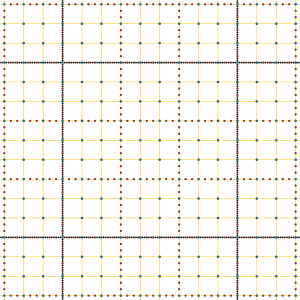Danzer set
In geometry, a Danzer set is a set of points that touches every convex body of unit volume. Ludwig Danzer asked whether it is possible for such a set to have bounded density.[1][2] Several variations of this problem remain unsolved.
| Unsolved problem in mathematics: Does a Danzer set with bounded density or bounded separation exist? (more unsolved problems in mathematics) |

Density
One way to define the problem more formally is to consider the growth rate of a set in -dimensional Euclidean space, defined as the function that maps a real number to the number of points of that are within distance of the origin. Danzer's question is whether it is possible for a Danzer set to have growth rate , the growth rate of well-spaced point sets like the integer lattice (which is not a Danzer set).[1]
It is possible to construct a Danzer set of growth rate that is within a polylogarithmic factor of . For instance, overlaying rectangular grids whose cells have constant volume but differing aspect ratios can achieve a growth rate of .[3] Constructions for Danzer sets are known with a somewhat faster growth rate, , but the answer to Danzer's question remains unknown.[4]
Bounded coverage
Another variation of the problem, posed by Timothy Gowers, asks whether there exists a Danzer set for which there is a finite bound on the number of points of intersection between and any convex body of unit volume.[5] This version has been solved: it is impossible for a Danzer set with this property to exist.[6]
Separation
A third variation of the problem, still unsolved, is Conway's dead fly problem. John Horton Conway recalled that, as a child, he slept in a room with wallpaper whose flower pattern resembled an array of dead flies, and that he would try to find convex regions that did not have a dead fly in them.[7] In Conway's formulation, the question is whether there exists a Danzer set in which the points of the set (the dead flies) are separated at a bounded distance from each other. Such a set would necessarily also have an upper bound on the distance from each point of the plane to a dead fly (in order to touch all circles of unit area), so it would form a Delone set, a set with both lower and upper bounds on the spacing of the points. It would also necessarily have growth rate , so if it exists then it would also solve the original version of Danzer's problem. Conway offered a $1000 prize for a solution to his problem,[7][8] as part of a set of problems also including Conway's 99-graph problem, the analysis of sylver coinage, and the thrackle conjecture.[8]
Additional properties
It is also possible to restrict the classes of point sets that may be Danzer sets in other ways than by their densities. In particular, they cannot be the union of finitely many lattices,[3] they cannot be generated by choosing a point in each tile of a substitution tiling (in the same position for each tile of the same type), and they cannot be generated by the cut-and-project method for constructing aperiodic tilings. Therefore, the vertices of the pinwheel tiling and Penrose tiling are not Danzer sets.[4]
See also
- Heilbronn triangle problem, on sets of points that do not form triangles of small area
- Minkowski's theorem, that every unit-volume closed convex body that is centrally symmetric around the origin contains a nonzero point of the half-integer lattice
References
- Croft, Hallard T.; Falconer, Kenneth J.; Guy, Richard K. (1991), "E14: Positioning convex sets relative to discrete sets", Unsolved problems in geometry, Problem Books in Mathematics, Springer-Verlag, New York, p. 148, doi:10.1007/978-1-4612-0963-8, ISBN 0-387-97506-3, MR 1107516
- Fenchel, Werner (1967), "Problems", Proceedings of the Colloquium on Convexity, Copenhagen, 1965, Copenhagen: Kobenhavns Universitets Matematiske Institut, pp. 308–325, MR 0214420, Problem 6 (Danzer), as cited by Croft, Falconer & Guy (1991)
- Bambah, R. P.; Woods, A. C. (1971), "On a problem of Danzer", Pacific Journal of Mathematics, 37: 295–301, MR 0303419
- Solomon, Yaar; Weiss, Barak (2016), "Dense forests and Danzer sets", Annales Scientifiques de l'École Normale Supérieure, 49 (5): 1053–1074, arXiv:1406.3807, doi:10.24033/asens.2303, MR 3581810
- Gowers, W. T. (2000), "Rough structure and classification", Geometric and Functional Analysis (Special Volume, Part I): 79–117, doi:10.1007/978-3-0346-0422-2_4, MR 1826250
- Solan, Omri; Solomon, Yaar; Weiss, Barak (2017), "On problems of Danzer and Gowers and dynamics on the space of closed subsets of ", International Mathematics Research Notices (21): 6584–6598, arXiv:1510.07179, doi:10.1093/imrn/rnw204, MR 3719473
- Roberts, Siobhan (2015), Genius at Play: The Curious Mind of John Horton Conway, New York: Bloomsbury Press, p. 382, ISBN 978-1-62040-593-2, MR 3329687
- Conway, John H., Five $1,000 Problems (Update 2017) (PDF), On-Line Encyclopedia of Integer Sequences, retrieved 2019-02-12. See also OEIS sequence A248380.